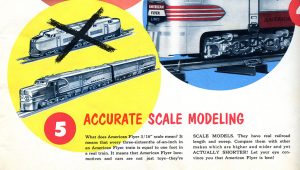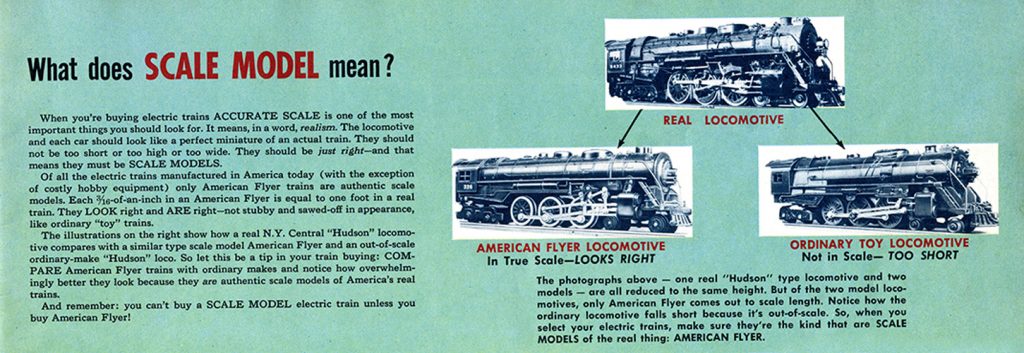A very high percentage of the S-gauge hobbyists started their hobby with American Flyer (AF), which was popularized by the A.C. Gilbert Company’s introduction of 3/16″ = 1′ trains after World War II. Often the trains came out at Christmas time, and boys with those trains often developed a life-long love for those trains. From the very beginning, Gilbert promoted their trains as scale models as seen in the catalog pages below. And, for the most part, what was produced was fairly accurate.
(Click on photos to enlarge)
Toward the final years of the company, however, some trains were produced that were not very accurate as models. A.C. Gilbert went out of business in 1966 and American Flyer train production stopped.
In addition to Gilbert, there have always been smaller, less-well-known companies producing S-sized (scale) trains. Most of the models have been made with compatibility with the Gilbert S-scale models, which means that they had large wheel flanges and couplers. Such models are commonly referred to as “hi-rail” because of the AF compatibility and the large rail that Gilbert produced. They can run with AF rolling stock without modification.
There have been several companies that have entered the S-scale market making hi-rail and scale models (see the Scale-S section of this website). These include American Models, S-Helper Service (now MTH), S Scale America and many others. Generally the trend has been to produce an accurate S-scale model and offer it with hi-rail wheels and couplers, as the greatest percentage of S hobbyists want AF compatibility.
The Pittsburgh S-Gaugers club follows the trend, and the majority of our members have AF and modern hi-rail models. However, we do have a number of “scalers” and even narrow gauge “scalers”. (Narrow gauge was not uncommon in our area in the 1800’s.) Together, we are working to share our hobby and introduce others to the “ideal size” of model trains – S Gauge.
Click on “Scale-S” in the menu for scale information.



